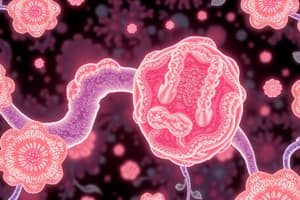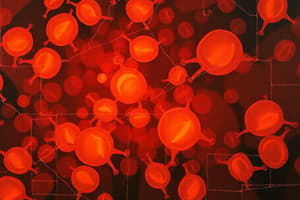Podcast
Questions and Answers
Define MHC molecules?
Define MHC molecules?
Membrane-associated glycoprotein molecules whose function is to bind peptide antigens and present them to T cells.
Function of MHC class I molecules involves binding and transport of peptide antigens generated in the cytosol to the cell surface for recognition by ___ T cells.
Function of MHC class I molecules involves binding and transport of peptide antigens generated in the cytosol to the cell surface for recognition by ___ T cells.
CD8
What is the function of MHC class II molecules?
What is the function of MHC class II molecules?
Binding and transport of peptide antigens generated in the endocytic vesicles to the cell surface for recognition by CD4 T cells.
MHC class I molecule consists of a transmembrane ___ chain, a-chain, which has 3 extracellular domains (a1, a2 and a3).
MHC class I molecule consists of a transmembrane ___ chain, a-chain, which has 3 extracellular domains (a1, a2 and a3).
The ___ domains, farthest from the membrane, form the peptide binding site.
The ___ domains, farthest from the membrane, form the peptide binding site.
The MHC class I heavy chain is encoded by a gene in the MHC on chromosome ___.
The MHC class I heavy chain is encoded by a gene in the MHC on chromosome ___.
There is also a covalently complexed invariant polypeptide, ___ (also called the light chain of class I MHC molecule), which is on chromosome __.
There is also a covalently complexed invariant polypeptide, ___ (also called the light chain of class I MHC molecule), which is on chromosome __.
MHC class II molecule consists of two transmembrane chains; one ___ and one ___ chain.
MHC class II molecule consists of two transmembrane chains; one ___ and one ___ chain.
One domain from each chain, farthest from the membrane, contributes to form the peptide binding site (___ and ___).
One domain from each chain, farthest from the membrane, contributes to form the peptide binding site (___ and ___).
What does the a3 domain of MHC class I bind to?
What does the a3 domain of MHC class I bind to?
What does the b2 domain of MHC class II bind to?
What does the b2 domain of MHC class II bind to?
Class I is expressed on all ___ cells, especially ___ cells.
Class I is expressed on all ___ cells, especially ___ cells.
What are the 6 isotypes of MHC class I molecules?
What are the 6 isotypes of MHC class I molecules?
What are HLA-E and HLA-G?
What are HLA-E and HLA-G?
What are the 5 isotypes of MHC class II molecules?
What are the 5 isotypes of MHC class II molecules?
What is the function of HLA-DM and HLA-DO?
What is the function of HLA-DM and HLA-DO?
What are 3 factors that dictate polymorphism and thus diversity?
What are 3 factors that dictate polymorphism and thus diversity?
What does polygeny refer to?
What does polygeny refer to?
At the event of antigen presentation, the peptide/MHC complex is recognized by TCR. TCR binds to what?
At the event of antigen presentation, the peptide/MHC complex is recognized by TCR. TCR binds to what?
This restriction in antigen specificity of T cells due to MHC is called what?
This restriction in antigen specificity of T cells due to MHC is called what?
MHC molecules bind peptides via ___ on the peptide.
MHC molecules bind peptides via ___ on the peptide.
The existence of ___ expands the number of different peptides that an individual can present.
The existence of ___ expands the number of different peptides that an individual can present.
Co-dominant expression maximizes what?
Co-dominant expression maximizes what?
All the alleles involved with HIV progression (or slowing) are MHC class ___, which is associated with ___ from cytotoxic CD8 T cells.
All the alleles involved with HIV progression (or slowing) are MHC class ___, which is associated with ___ from cytotoxic CD8 T cells.
What are the two ways of possible cross-reactive recognition in T cell alloreactivity?
What are the two ways of possible cross-reactive recognition in T cell alloreactivity?
What are superantigens (SAgs)?
What are superantigens (SAgs)?
What are two examples of bacterial superantigens?
What are two examples of bacterial superantigens?
Superantigen binds to the ___ region of TCR and to the ___ of MHC class II molecule.
Superantigen binds to the ___ region of TCR and to the ___ of MHC class II molecule.
SAg induces a ___ T cell response resulting in production of large amounts of ___ responsible for inducing a ___
SAg induces a ___ T cell response resulting in production of large amounts of ___ responsible for inducing a ___
SAg also inhibits the induction of what?
SAg also inhibits the induction of what?
Flashcards are hidden until you start studying
Study Notes
MHC Molecules Overview
- MHC (Major Histocompatibility Complex) molecules are membrane-associated glycoproteins that bind peptide antigens for T cell recognition.
- MHC class I presents antigens to CD8 T cells, while MHC class II presents to CD4 T cells.
Functions of MHC Class I Molecules
- Transport peptide antigens from the cytosol to the cell surface for CD8 T cell recognition.
- Involved in IgG uptake in the gut and regulation of iron metabolism and NK cell function.
Functions of MHC Class II Molecules
- Bind and transport peptide antigens from endocytic vesicles to the cell surface for recognition by CD4 T cells.
Structure of MHC Class I Molecules
- Comprises a heavy chain (transmembrane α-chain) with three extracellular domains (α1, α2, α3), forming the peptide binding site.
- Heavy chain encoded by MHC genes on chromosome 6, with a covalently bound light chain known as β2 microglobulin encoded on chromosome 15.
Structure of MHC Class II Molecules
- Consists of two transmembrane chains: α and β, both encoded by MHC genes.
- Peptide binding site formed by one domain from each chain (α1 and β1) located farthest from the membrane.
Binding and Recognition
- The α3 domain of MHC class I binds to the CD8 co-receptor, ensuring presentation to CD8 T cells.
- The β2 domain of MHC class II binds to the CD4 co-receptor for presentation to CD4 T cells.
Expression Patterns
- MHC class I is expressed on all nucleated cells, especially hematopoietic cells; red blood cells lack MHC class I expression.
- MHC class II is expressed primarily on professional antigen-presenting cells (APCs) like dendritic cells, macrophages, and B cells.
Isotypes of MHC Class I Molecules
- Six isotypes: HLA-A, HLA-B, HLA-C, and HLA-G, with HLA-G being less polymorphic.
- Highly polymorphic isotypes present antigens to CD8 T cells and are ligands for NK cell receptors.
Isotypes of MHC Class II Molecules
- Five isotypes: HLA-DP, HLA-DQ, HLA-DR, HLA-DM, and HLA-DO.
- HLA-DR is highly polymorphic and directly presents peptides to CD4 T cells.
Functions of HLA-DM and HLA-DO
- HLA-DM regulates peptide loading on HLA-DP, HLA-DQ, and HLA-DR.
MHC Polymorphism and Diversity
- Diversity is driven by polymorphism, polygeny (multiple similar genes), and co-dominant expression of alleles.
- Co-dominant expression maximizes the number of MHC molecules an individual can express.
MHC Restriction
- T cell receptors (TCRs) recognize complex peptides bound to MHC molecules, known as MHC-restriction, influencing T cell specificity.
MHC Class I and HIV Progression
- Alleles related to HIV progression are associated with MHC class I molecules and their role in cytotoxic CD8 T cell activity against virus-infected cells.
T Cell Alloreactivity
- Cross-reactivity of TCRs can be explained by peptide dominant and MHC dominant bindings, influencing the immune response during transplants.
Superantigens (SAgs)
- Distinct antigens that stimulate T cell responses by presenting intact proteins through MHC class II, as opposed to standard peptide presentation.
- Examples include Staphylococcal enterotoxin and Toxic shock syndrome toxin.
Mechanism of Superantigens
- Superantigens bind the Vβ region of the TCR and the outer surface of MHC class II, inducing polyclonal T cell activation and massive cytokine production, leading to systemic shock.
- They inhibit the induction of specific adaptive responses, favoring bacterial pathogenicity.
Studying That Suits You
Use AI to generate personalized quizzes and flashcards to suit your learning preferences.




